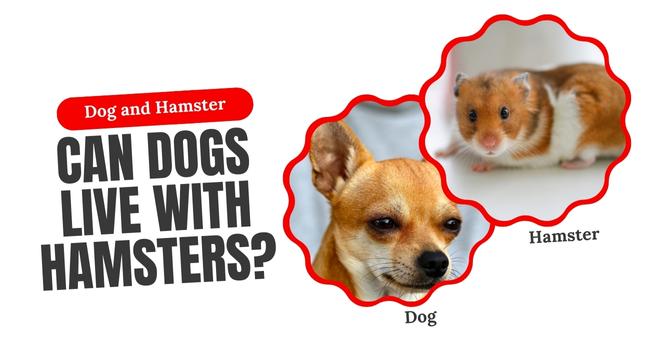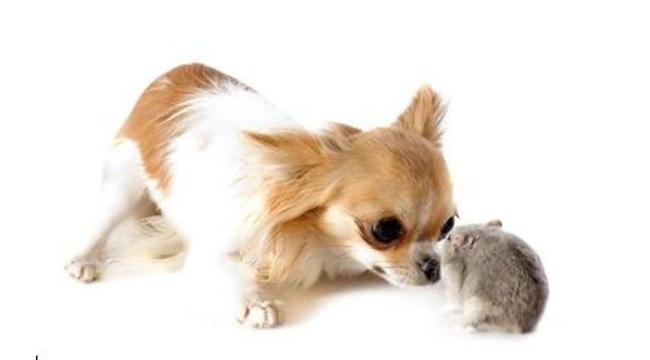
Can You Choose Dogs with Hamsters when you would prefer to have another pet at home?
Many families that love having a dog as a pet would prefer to have another pet at home.
Many members of the same family living together might want their own pets. So why not choose to have dogs and hamsters together?
Both of them are easy to have as pets and fun to play with.
Most hamster breeds love playing around with their wheels and tubes. But will your cute hamster appeal to your dog in a different way?
Your dog might want to be affectionate, but it might end up slapping the hamster playfully with its paw, and it might end up in a fatal encounter with the cute little hamster.
- The Different Types of Emotional Support Animals
- 6 Pets You Can Keep in Your College Dorm
- Pros And Cons About Feeding a Dog With Raw Meat
- 6 Smart Tips on Picking the Best Pet Food
- The Comprehensive Overview on Different Dog Breeds
How To Know If Your Dog Is Too Much Into Your Hamster
Dogs are generally very alert to their environment, which allows them to easily use their powerful sense of smell to sniff out small animals like cute little hamsters. However, when a dog’s senses are heightened, it may become very interested in and try to interact with the hamster, since dogs naturally have hunting instincts. This may cause the dog to appear aroused and playful, but it is actually trying to seek out the hamster with a hunter’s instinct.
It’s important to carefully observe your dog’s body language during this time. If your dog is interested in the hamster in a non-aggressive way, there isn’t much to be concerned about. It may simply be focused on the hamster and staring alertly at it, using its heightened sense of smell to sniff it out, wagging its tail to show excitement, and observing the hamster’s movements.
However, if your dog is responding to the hamster as prey, there are some signs to watch out for, such as barking, growling, panting, and raised ears. If these signs are present, there is a possibility that the dog may try to pounce on the hamster’s location and exhibit predator-prey behavior. This may cause the hamster to exhibit stress-like symptoms such as shaking. Therefore, it’s important to monitor your dog closely when around small animals like hamsters.
History Of The Hamster vs Dog
The history behind dogs vs. hamsters can be traced back to the evolution of the dog species. Charles Darwin described how domestic dogs have descended from jackals and wolves, and although they may not have gained in cunning, they have progressed in certain moral qualities such as trustworthiness, affection, and temper. This evolution has made it possible for us to think that dogs and hamsters can coexist in the same house.
However, dogs are instinctively predatory in nature and have a natural inclination to hunt. The smell, sight, and movements of a hamster can trigger a dog’s predator instincts, making it appear as prey. Some breeds of dogs, especially hunting dogs, may not be trustworthy around other small animals in the home, as they were bred to hunt prey. Other more passive companion breeds may be less openly aggressive, but they still have the basic instinct to seek small creatures.
Despite the domestication of dogs, their basic instincts cannot be trusted entirely, and it’s important to monitor their behavior closely around small animals like hamsters. Dogs connect the wild with the tame and join nature and culture. However, their natural instincts cannot be ignored, and it’s crucial to understand their predatory nature when bringing them into a home with other animals.
The Dog And Hamster Interaction According To Science
All dogs are naturally equipped with the drive to prey and the skills required to master that disposition. Several factors can trigger a dog’s prey drive. The breed and personality of the dog are often considered when describing the science behind their predatory behavior.
The four main factors that make your dog more likely to pounce on the hamster are:
- Breed: hunting comes more naturally to some breeds than others.
- Social facilitation: this is broadly caused by the absence or presence of others to restrict the predatory behavior of the dog.
- Opportunity: this describes the freedom the dog has when it’s with the prey.
- Learning: if the dog is rewarded once for hunting, it will be more eager to hunt again.
The hunt itself can occur in two phases: the phase of appetite and the phase of consumption. According to their basic instinct, dogs naturally hunt to eat, primarily using their sense of smell and memory to track their prey. In the wild, dogs often hunt in packs, surrounding their prey and preventing it from fleeing.
Similarly, a pet dog may view other small animals in the house as prey and attempt to corner them. However, domesticated dogs are trained and bred differently, so their response to prey will vary.
For example, a pointer dog may simply point to the prey rather than trying to eat it. The keenest hunting instincts are typically found in breeds such as pointers, spaniels, retrievers, and setters. As a result, these breeds may not be well-suited for living with hamsters or other small animals in the same household.
How to Keep a Hamster and a Dog Together

Hamsters are cute and lovable creatures that make great pets. They are small, cuddly, and playful, and many people love to keep them as pets. But if you are a dog owner and you are thinking of getting a hamster, you might be wondering if it is safe to keep a hamster and a dog together. The good news is that it is possible to keep both pets safely, but it requires some planning and precautions.
Here are some tips on how to keep a hamster and a dog together:
Choose the right type of hamster
Before you bring a hamster into your home, it is important to consider the breed of hamster you want. Some breeds of hamsters are more aggressive and territorial than others, and may not be a good fit for a home with a dog. Syrian hamsters, for example, are known for being more territorial and may become stressed or aggressive if they feel threatened by a dog. On the other hand, dwarf hamsters tend to be more sociable and may be a better fit for a home with a dog.
Introduce your pets slowly and carefully
When introducing your hamster and dog for the first time, it’s important to do so slowly and carefully. Start by placing your dog on a leash and allowing it to sniff around the room where your hamster’s cage is located. If your dog seems calm and curious but not aggressive, you can bring the hamster out of its cage and hold it while allowing your dog to sniff it. If your dog shows any signs of aggression or excitement, separate them immediately and try again later.
Keep food and water separate
It’s important to keep your hamster’s food and water out of reach of your dog. Place the hamster’s food and water dishes in a location where your dog cannot access them, such as on a high shelf or in the hamster’s cage. This will prevent your dog from eating your hamster’s food or drinking its water, which could make your hamster sick.
Provide plenty of exercise for your dog
Dogs need plenty of exercise to stay healthy and happy, but it’s important to provide this exercise away from your hamster’s cage. Take your dog for walks, runs, and playtime outside of the room where your hamster’s cage is located. This will reduce the risk of your dog accidentally injuring or scaring your hamster.
Consider a separate room for your hamster
If you have a large dog or one that is particularly curious or excitable, you may want to consider keeping your hamster in a separate room. This will provide your hamster with a safe and secure environment, and reduce the risk of your dog accidentally harming it.
Prepare a safe and secure home for your hamster
Hamsters are small and vulnerable, so it is important to provide them with a safe and secure living environment. Choose a cage that is escape-proof and has a solid bottom. Make sure the cage is elevated and out of reach of your dog. Keep the cage in a room where your dog cannot access, such as a bedroom or a study. Make sure the cage has plenty of toys and hiding spots for your hamster to feel safe and comfortable.
Train your dog to be gentle around the hamster
Dogs are naturally curious and may see a hamster as prey. It is important to train your dog to be gentle around your hamster. Start by teaching your dog basic obedience commands such as “sit”, “stay”, and “leave it”. When your dog is around the hamster, keep a close eye on them and use positive reinforcement to reward good behavior. If your dog shows signs of aggression or excitement around the hamster, separate them immediately.
Supervise all interactions between your dog and hamster
Even if your dog is well-behaved around your hamster, it is important to supervise all interactions between the two pets. Never leave your dog and hamster alone together, even for a short period of time. Keep the hamster’s cage securely locked when you are not around to supervise.
Give your hamster time to acclimate to its new environment
Hamsters are sensitive creatures and can become stressed by changes in their environment. When you first bring your hamster home.
give it time to acclimate to its new environment before introducing it to your dog. Keep the hamster’s cage in a quiet room for a few days to help it adjust to its new surroundings. Once your hamster seems comfortable and settled, you can slowly introduce it to your dog while supervising their interactions.
Provide separate playtime for your pets
While it may be tempting to let your hamster and dog play together, it is best to provide separate playtime for each pet. Set up a play area for your hamster outside of its cage where it can safely explore and play without the risk of being chased or injured by your dog. Similarly, take your dog for walks and playtime outside of the room where your hamster’s cage is located.
In conclusion, keeping a hamster and a dog together is possible with proper planning and precautions. Choose the right type of hamster, provide a safe and secure home, train your dog to be gentle, supervise all interactions, give your hamster time to adjust, and provide separate playtime for each pet. With patience and care, your hamster and dog can coexist happily and peacefully in your home.
If you’re looking for comprehensive and reliable information on how to properly care for your furry companion, then you may want to consider visiting DoggyBlogger.com. This website is dedicated to providing a wealth of resources and tips for dog owners, ranging from the basics of dog grooming and nutrition to more advanced topics like obedience training and behavioral issues.



